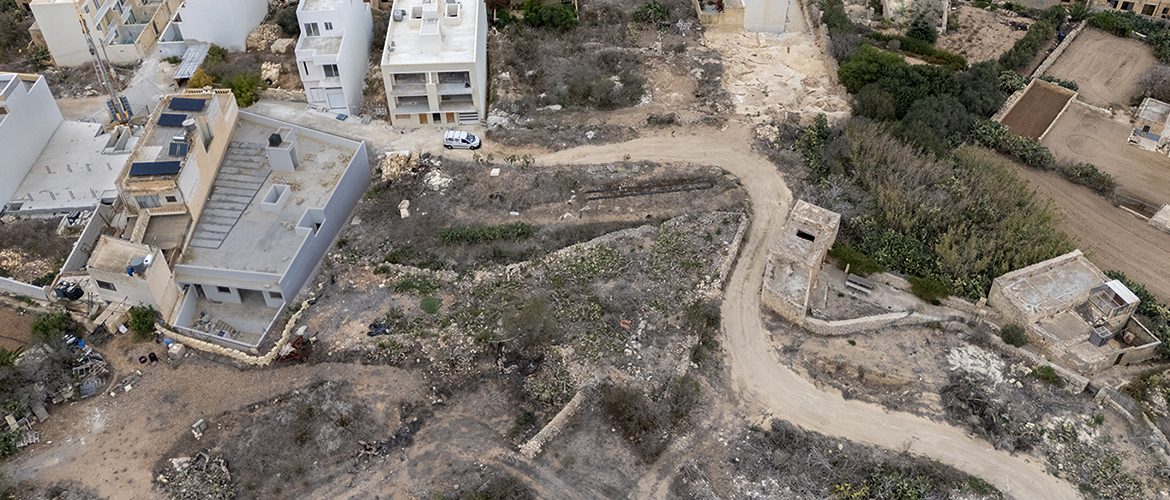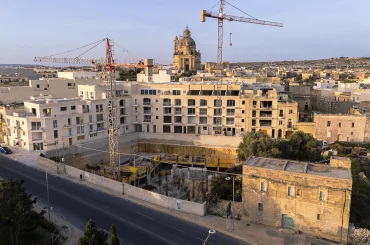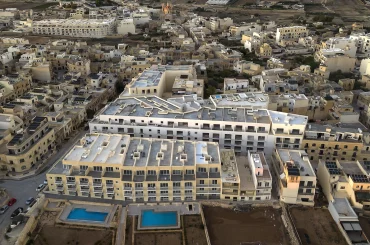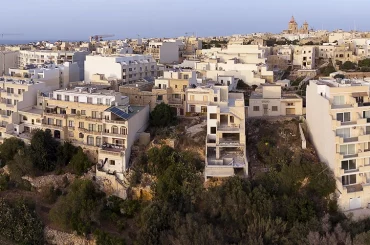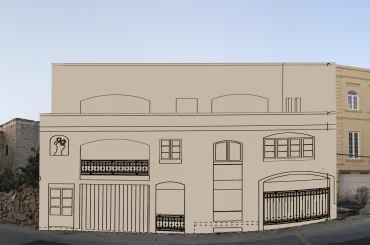The Superintendence of Cultural Heritage has told the Planning Authority that there are no archeological remains within the site of a development application for seven houses even though the Superintendence’s own archeologists have in recent months excavated a significant Neolithic burial pit at the site, an investigation by this website can reveal.
The development site is situated about 200 metres away from Santa Verna, a megalithic site dating to the Neolithic era. The applicant, James Borg, already has permission to build four houses, and last April he applied to extend the development to seven houses. The houses began to be promoted for sale on Facebook even before he put in the application form.

In a letter about the case to the Planning Authority dated 9 August 2023, the Superintendence, which is tasked with protecting Malta’s cultural heritage, wrote that “while significant archaeological remains have been recorded in the vicinity, these are not located within the site subject to the current application which has been investigated.”
But this website has obtained a report written by one of the Superintendence’s archeologists, Bernardette Mercieca-Spiteri, following excavations on the site of the current application that took place last May and June – before the Superintendence’s letter of 9 August. The archeologist’s ‘preliminary report’ was written last month, and it describes a “burial pit” dating to the “temple period” (when the Neolithic temples were constructed) in which human and animal bones were found alongside sherds of pottery.
The archeologists who excavated the site found evidence of so-called burial rituals. Their report highlights the presence of “large quantities” of bones, including seven skulls, “belonging to young individuals.”

“Some of the skulls were positioned inside other broken skulls,” the archeologists wrote in their report. “This has been interpreted as an intentional and careful arrangement of human remains carried out in prehistoric times. Near the skulls, and throughout the northern half of the pit, the concentration of human remains, as well as animal bones, increased. Although disarticulated, the act of placing these bones (human and animal) with some organization (the line of human skulls) indicates that this is a secondary burial ritual that took place in the prehistoric period. It may indicate that these bones were taken from a nearby primary burial location after the bones had become skeletonized and positioned in this pit as part of a burial ritual.”

The archeologists wrote about damage to the burial pit during excavations for an earlier development permission. Those excavations got underway last Spring. They wrote that the artefacts or finds were “concentrated at the sides of the pit, this probably due to machinery having removed some of the soil in the middle part of the pit before the feature was identified as a burial pit during development surveillance works.”

It is not clear who reported the discovery. An archeologist working under terms imposed by the Superintendence had been monitoring last Spring’s excavation works. But it was a resident, Carmen Bajada, who then noticed broken bones sticking through the soil and reported the case to the Superintendence. She also informed the NGO Flimkien Ghal Ambjent Ahjar, which issued a press statement.

Works continued at least for a few days even after Bajada sent her email to the Superintendence, which was handled by an executive within the office of Superintendent Kurt Farrugia. Soil or rubble continued be carted away according to residents, and an underground cave had its roof smashed in by the time the works were stopped.
Footage and pictures passed on to this website show various caves in the area. This includes the underground cave on the site of the development application that had evidently been used at one point to hold domestic farm animals, either cows or sheep.

The Superintendence did not mention the presence of the cave in its letter to the Planning Authority.
The area itself was put into the development zone as part of the so-called rationalistion scheme in 2006. A superficial archeological assessment was carried out prior to its inclusion in the rationalization scheme – and it was on the basis of that superficial assessment that the area was rezoned into a development area.
At the time, the Labour Party in opposition had vowed to review the rezonings. But Labour did not review any of the rezonings when it was elected to government in 2013. Instead, it took to dismantling some of the planning controls and policies to make it easier to build higher and denser and to build in the countryside.
The re-zoned area, which is larger than two football pitches, is now being largely developed into either blocks of flats, and rows of nondescript houses.

The latest application in the area is for a row of 11 houses built over four floors by an applicant named Thomas Grech. A Thomas Grech is a manager of PRA Construction Limited, a company owned by Joseph Portelli and two of his Gozitan partners.
Thomas Grech had also been the applicant for a block of 54 flats at Ta Zejta which is being developed by Joseph Portelli and his partners.

The application for seven houses was recommended for approval by the case officer. The case officer wrote that the application is “in line with DC15, Policies P32, P26, and P45.” But P26 says that “site frontage will not be less than 6 metres in the case of terraced residential development” – and the proposed 7 houses are less than 4 metres in width.
I made this point during the meeting of the Planning Commission, and the Commission then turned the non-adherence to P26 as a “reason for refusal.” The next hearing is scheduled for 6 December.
I need a small favour...
It takes me much time, resources, and effort for investigations in the Planning Emergency series. And in this case, it is thanks to my intervention that the Planning Authority turned a recommendation for approval into a reason for refusal last month. This year I tried to raise €1,000 for my journalistic investigations into damaging developments, but less than €20 has been raised from donations at time of publishing this article. Give me heart and sustenance by donating as little as €5.

